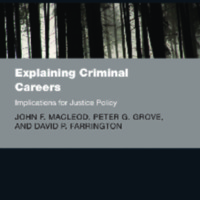Explaining Criminal Career
Dublin Core
Subject
Description
Explaining Criminal Careers presents a simple quantitative theory of crime, conviction and reconviction, the assumptions of the theory are derived directly from a detailed analysis of cohort samples drawn from the “UK Home Office” Offenders Index (OI). Mathematical models based on the theory, together with population trends, are used to make: exact quantitative predictions of features of criminal careers; aggregate crime levels; the prison population; and to explain the age-crime curve, alternative explanations are shown not to be supported by the data. Previous research is reviewed, clearly identifying the foundations of the current work. Using graphical techniques to identify mathematical regularities in the data, recidivism (risk) and frequency (rate) of conviction are analysed and modelled. These models are brought together to identify three categories of offender: high-risk / high-rate, high-risk / low-rate and low-risk / low-rate. The theory is shown to rest on just 6 basic assumptions. Within this theoretical framework the seriousness of offending, specialisation or versatility in offence types and the psychological characteristics of offenders are all explored suggesting that the most serious offenders are a random sample from the risk/rate categories but that those with custody later in their careers are predominantly high-risk/high-rate. In general offenders are shown to be versatile rather than specialist and can be categorised using psychological profiles. The policy implications are drawn out highlighting the importance of conviction in desistance from crime and the absence of any additional deterrence effect of imprisonment. The use of the theory in evaluation of interventions is demonstrated.
Source
http://oapen.org/download?type=document&docid=468332
Publisher
Contributor
Rika Zulfia
Rights
Creative Commons
Type
Files
Collection
Citation
John F. Macleod, , Peter G. Grove, , and David P. Farringtz, “Explaining Criminal Career,” Open Educational Resources (OER) , accessed December 10, 2025, http://oer.uinsyahada.ac.id/items/show/493.


